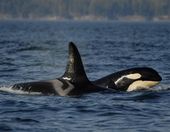Seattle - Seven Puget Sound killer whales are missing and presumed dead in what could be the biggest decline among the sound's orcas in nearly a decade, say scientists who carefully track the endangered animals.
"This is a disaster," Ken Balcomb, a senior scientist at the Center for Whale Research on San Juan Island, said Friday. "The population drop is worse than the stock market."
While the official census won't be completed until December, the total number of live "southern resident" orcas now stands at 83.

© AP file photo
Among those missing since last year's count are the nearly century-old leader of one of the three southern resident pods, and two young females who recently bore calves. The loss of the seven whales, Balcomb said, would be the biggest decline among the Puget Sound orcas since 1999, when the center also tracked a decline of seven whales.
Low numbers of chinook salmon, a prime food for these whales, may be a factor in the unusual number of deaths this year, Balcomb said.
"It was a bad salmon year and that's not good for the whales," he said. "Everybody considers these wonderful creatures, but we really have to pay attention to the food supply."
The three pods, or families, that frequent western Washington's inland marine waters - the J, K, and L pods - are genetically and behaviorally distinct from other killer whales. The sounds they make are considered a unique dialect, they mate only among themselves, eat salmon rather than marine mammals and show a unique attachment to the region.
The population reached 140 or more in the last century, but their numbers have fluctuated in recent decades. They were listed as endangered in 2005.
"We may be in the beginning of another decline in the population," said Howard Garrett, director of the Orca Network, a nonprofit education and advocacy group.
He said the whales seem to be having a harder time finding chinook salmon.
The whales recently have been traveling over greater distances than usual, suggesting they may be ranging farther for food, said Brad Hanson, a wildlife biologist with the National Marine Fisheries Service.
Lack of food may be a concern, but it's too early to know the reason for the unusual number of presumed deaths, he said.
Pollution and a decline in prey are believed to be the whales' biggest threats, although stress from whale-watching tour boats and underwater sonar tests by the Navy also have been concerns. In the late 1960s and early '70s, the population fell as dozens were captured for marine parks.
The whales were making an apparentg comeback in recent years, reaching 90 in number in 2005, "but it's been a downhill trend now for three years," Balcomb said.
Among those missing are two female whales of reproductive age, both of which recently produced calves. One of those calves, L-111, is missing, while the other, J-39, is not.
It's not unusual to lose older or younger whales, but losing two females in reproductive prime is "a bit of a concern" since they typically have a high survival rate, Hanson said.
One female whale, known to scientists as L-67, had the potential for two or three more calves, Hanson said.
She was the mother of "Luna," a juvenile killer whale from Washington waters that made headlines in 2001 when he became separated from his pod and turned up in Nootka Sound, off the west coast of Canada's Vancouver Island. A killer whale believed to be Luna died in Nootka Sound in 2006 when it was hit by the propeller of a large tugboat.
L-67 showed clear signs of emaciation - a depression behind her blow hole - before she disappeared in September, Hanson said.
"It definitely shows that she was not eating," he said, but it's unclear why. Researchers are performing tests on samples they collected from her weeks before she disappeared.
Others missing, according to the center, include K-7, the 98-year-old matriarch of K-pod, and L-101, a 6-year-old male who is a brother of "Luna."
The count also includes a calf, J-43, that was born in November but is believed to have not survived the winter.
The whale census may increase if baby orcas are born this fall. And there's a slim chance the whales may reappear elsewhere, as "Luna" did, Hanson said.
Reader Comments
to our Newsletter